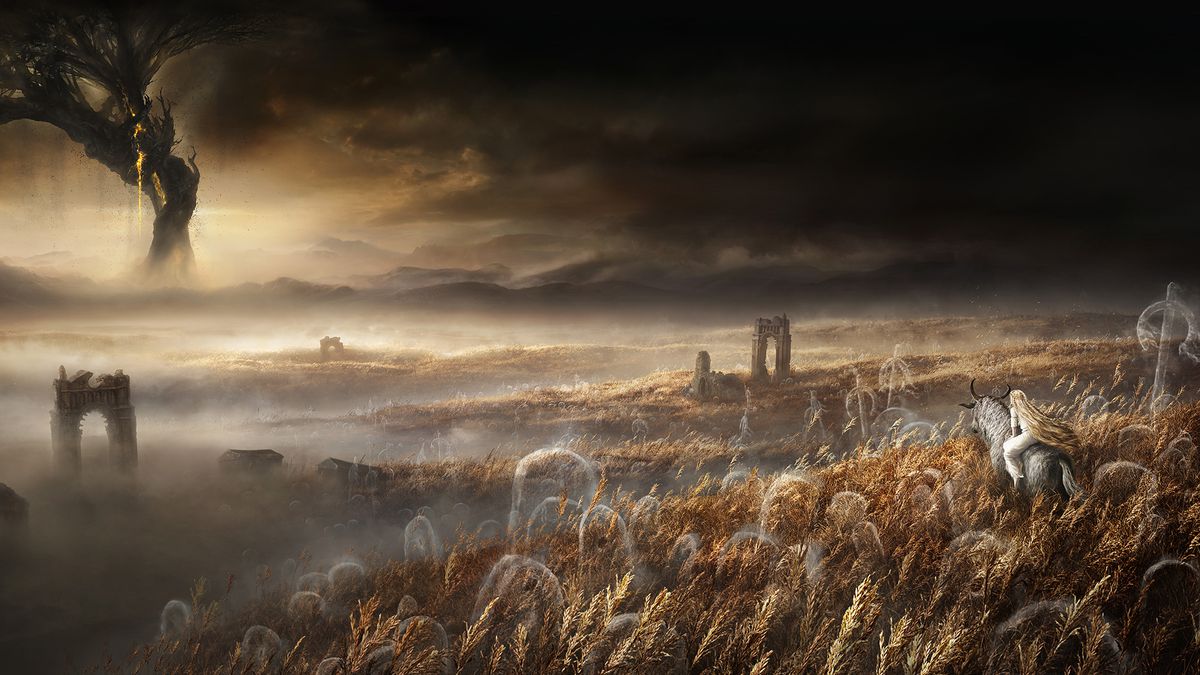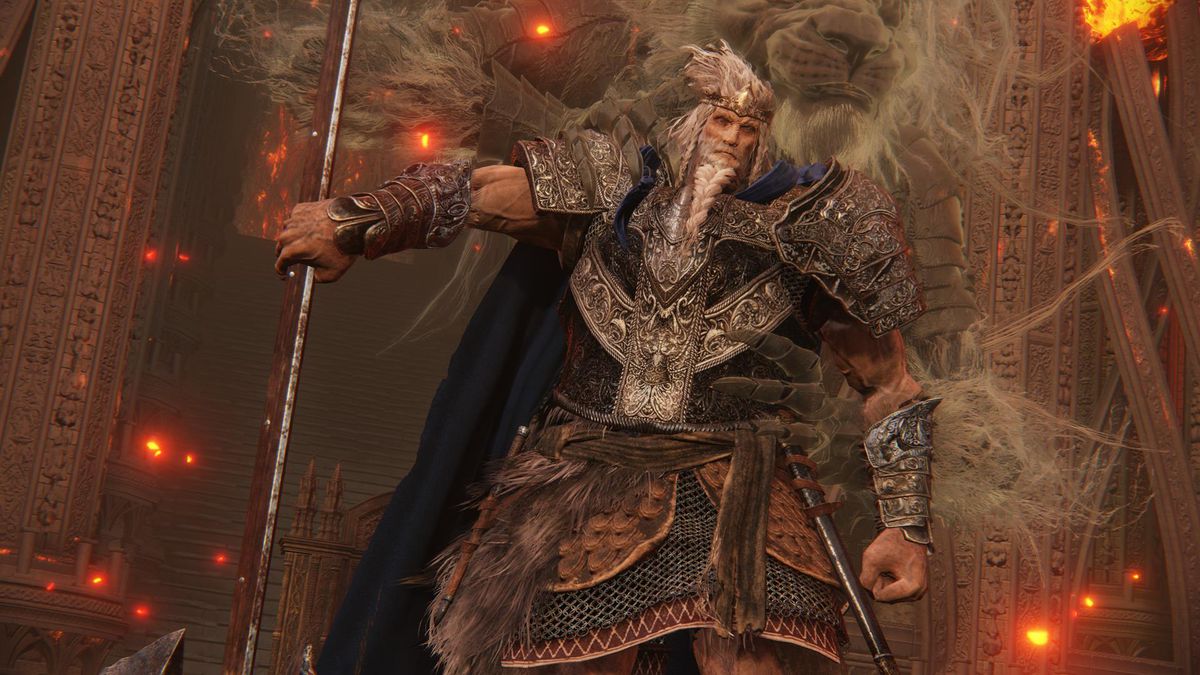Elden Ring’s story is often attributed to two people: FromSoftware president and creative director Hidetaka Miyazaki, and A Song of Ice and Fire author George R.R. Martin. This is only partially true. While Miyazaki is credited as the creative mind behind its dense lore and high-fantasy setting, a game as big as Elden Ring had a huge team working on it, and a lot of its story was crafted through gameplay and environmental world-building rather than through a more traditional narrative. Plus, there’s the whole Martin thing.
I’ve seen a lot of misunderstandings and confusion out there in regard to how much Martin contributed to Elden Ring. One review I read mentioned the author several times and even said the game features “Thrones-level twists,” as if Martin had written out each plot point himself. That said, the game was first marketed as “a new world filled with fantastic tales and lore” that had been “woven by Hidetaka Miyazaki […] and George R.R. Martin,” so Martin’s importance was put on the same level as Miyazaki’s — at least at that time. Confusion about his contributions is understandable when this is the information most visibly out there.
But what did Martin contribute exactly? Polygon combed through a ton of writing about the game, including posts from Martin’s blog and interviews with FromSoftware team members, to put together a better picture of his contribution. (We reached out to Bandai Namco and were denied a request for an interview. We also reached out to Martin’s agency for comment and didn’t receive a response by publication time.)
It all started with a meeting. According to an interview with Miyazaki in Edge Magazine, he and Martin first met at a hotel in the U.S. about a possible collaboration on FromSoftware’s next game. Martin wrote in a post on his blog that the team had reached out to him to create a “deep, dark, resonant world to serve as a foundation” for the game, including the “imaginary history.” While the Game of Thrones author hadn’t played too many video games, he had some familiarity with the Dark Souls series; but it was mostly Martin’s love of fantasy that caught Miyazaki’s attention.
“I knew immediately from talking to him, it just became apparent his skill and his passion for the fantasy genre, and for games as well,” Miyazaki said. “And it just felt so fresh to have those conversations with someone who was so passionate about the same things, and to show that pure joy and sense of curiosity for these fantasy worlds. This was something that really captured my interest throughout all of our talks, and I was really thrilled to be working with him.”

Over multiple meetings, the FromSoftware team and Martin came up with a plan for him to sketch out the history of the Lands Between and the mythology that would set the stage for when the player would jump into the story. Martin wouldn’t be writing any of the in-game text or dialogue, according to Miyazaki, but he could feel free to create whatever he wanted based on some undefined prompts.
“We started off by giving him these very vague and broad themes and ideas for the mythos that I had swimming around in my head, along with what kind of games we typically make, and the sort of themes we’d like to explore in our games,” Miyazaki told Edge. “So it was all very loose and quite vague. Then he would come back to us with a lot of ideas: how about this, this, and this? That back-and-forth started the exchange of ideas.”
Then, Martin got to work. He passed off a lot of text to the studio, but it’s unclear from various interviews what was actually in those documents. For a game as large and dense as Elden Ring, what a “foundation” or “mythos” could mean is vague. Did Martin craft a timeline? Did he write an outline? An encyclopedia? And, as was theorized by players, did he place his initials everywhere he could?
As for that last point, no — Martin says he didn’t include Easter eggs. He dedicated a whole blog post to that fact. (“[…] why would I have to hide my name inside the game? My name is right there ON the game, as one of the creators,” he wrote).
And as for the rest, we’ve got more interviews to wade through here. Elden Ring producer Yasuhiro Kitao said in an interview with The Verge that Martin formed “the mythos for the world, which takes place many, many years before the events of the game, and really shapes a lot of the current state of the world and its characters.” In this interview, Kitao seems to suggest that the author wrote just enough to serve as inspiration for the rest of the team, and that Miyazaki crafted most of the details, like the characters. “When George R.R. Martin says ‘Okay, here’s the mythos, do what you will with it,’ Miyazaki is just going to run with it,” Kitao said. “Miyazaki has really been free to take his own interpretations and create his own characters based off of that.”
Meanwhile, Martin explained in an appearance on The Late Show with Stephen Colbert that he actually put down a lot of detail in his contributions, saying he was in charge of world-building and some of the characters — or at least the historical ones.
[embedded content]
“Elden Ring was going to take place in, let’s say the present of their game universe. But what they wanted me to write was what happened like 5,000 years before that,” he said. “So I went back and wrote a history of what happened 5,000 years before the current game, and who all the characters were and who was killing each other and what powers they had. They had these runes that were at the center of the game, and the rune got split into many pieces, and that’s what screwed up the world. I laid all that out.”
This is echoed in that Edge interview by Miyazaki, who said Martin created a lot of the game’s historical characters. “When he wrote the mythos, we asked him to create these dramatic heroes of this ancient mythos that takes place before the events of the game. These dramatic and heroic characters weren’t really present in our previous titles, so this is something that was really appealing to me — how he would depict the mystique and heroic qualities of those characters.” The only character named here is Godfrey, First Elden Lord, but we can extrapolate that there are many more that Martin worked on.
After turning in his assignment, Martin said on his blog he went about his life for a few years until the game was released. Ultimately, he wrote that he had what he calls a “small” role in the making of Elden Ring and puts most of the credit on FromSoftware’s team. In a blog post, he wrote: “Of course, almost all the credit should go to Hidetaka Miyazaki and his astonishing team of games designers who have been laboring on this game for half a decade or more, determined to create the best videogame ever.”
In turn, Miyazaki told Edge that Martin’s work was a huge source of inspiration for the team. In fact, he said having an outside writer contribute in this way was the “largest impact on the game just because it was an approach I hadn’t used before. It allowed me to draw lines connecting the history in this new mythos and build up something very fresh. It provided a lot of motivation and a great, constant source of inspiration.”

This deal all sounds right up Martin’s alley. He is, after all, the author behind the long-running (and very delayed) A Song of Ice and Fire fantasy series, and one of its strongest aspects is its world-building, which is so extensive that it feels almost real. All of the core families have long histories that are intertwined, with multiple mythologies and stories that become fascinations of the world’s people and imprint on current events, and with some of these histories going back thousands of years. There are also prominent characters in the series, like “Mad King” Aerys II Targaryen or Lyanna Stark, who don’t even make actual appearances but are instead featured substantially in conversation, or mentioned in passing.
And isn’t this what Elden Ring offers? While you don’t need to pay attention to the “plot” to play the game, its world’s history — which you can glean from conversations, notes, and flavor text — is there to set a foundation and a reason for why the Lands Between exists as it does. Many of its most important characters don’t even show up beyond the occasional statue or item bearing their name.
The setup for DLC Shadow of the Erdtree has been so fascinating because it’ll delve into Miquella of the Haligtree, the brother of one of the base game’s most important bosses and a mighty, mythic figure in Elden Ring’s lore who never actually shows up in the original game beyond being a withered, rotting hand in a cocoon. Players already know a lot about him and what he’s been through from a historical standpoint, and they’ve been theorizing about what the DLC will entail because of what the game has already set up. Martin did not submit new material to Erdtree, according to Miyazaki, but it’s clear his contributions were still key. So whether he wrote your favorite character or not, it’s partly his world, too.








